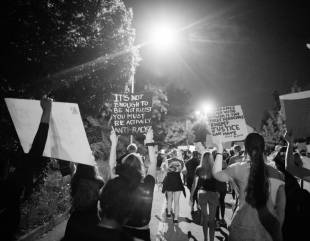There seems to be no end to the tragedies that come with the year 2020. First, we had to go on lockdown because of a deadly and unforgiving virus. Then, we had to protest our right to live, not counting, fair treatment as we stood and fought by the hashtag #blacklivesmatter.
Now, the very people who are supposed to protect us, and be our friends, are the ones slaughtering us without mercy—without any sense of conscience or morality. Well, as they say, every day is for the thief, but one day is for the owner of the house. Tragedy evokes an impulse to respond, and even though it took us this long, we have finally taken charge.
However, even though our right to free speech is and should be valued, the line between free speech and hate speech, catching cruise and protesting, violence and peace can be blurred.
Also Read: 7 Things You MUST NOT DO During a Peaceful Protest.
How do we raise our voices to address injustice in ways that promote peaceful and respectful communication, while also demonstrating strength and determined passion? Is it even possible?
We think it is.
Let’s look back in history. These people prove that peaceful and creative approaches to political activism can lead to success. We can learn from their approaches, while emulating their strength, bravery and unwavering peacefulness in the face of unprecedented adversity.
1. Women’s Suffrage Parade (1913).
“Because this is most conspicuous and important demonstration that has ever been attempted by suffragists in this country.
Because this parade will be taken to indicate the importance of the suffrage movement by the press of the country and the thousands of spectators from all over the US gathered in Washington for the Inauguration.”
This was the call sent to women in preparation for the largest organized parade of suffragists, who were marching to bring the attention of the government to the fact that they didn’t recognize women’s rights.
The call was answered. On March the 3rd, 1913, led by lawyer Inez Milholland, were 5000 women from numerous countries including bands, four mounted brigades, three heralds, and 24 decorated floats.
As soon as the protests began, swarms of onlookers, most of them men, attempted to disrupt their focus through insults and indecent comments. However, they refused to be deterred.
The New York Times described the parade as “one of the most beautiful spectacles ever staged in this country.”
2. The Singing Revolution (1986-1991).
Estonia was first captured by the Soviets in 1939, followed by the Nazis and then the Soviets. We all know that these countries were known for their terror and dictatorship, with more than half of the Estonian population deported to Siberia before the end of World War 2.
During these trying periods, song was a symbol of cultural heritage and served to maintain their culture, pride, and dignity, while promising them a hope of a better future.
Which is why all Estonian citizens, from the youngest to the oldest, took to the streets in protest when the Soviets outlawed singing of songs. With nothing but their voices as weapons, they all sang in unison their National Anthem.
They risked their lives, as this was easily a threat to the Soviet government because of the patriotism and passion that proclaimed their love for their nation.
These protests, which continued to grow in strength and numbers served to weaken the Soviet government and paved a way to restoring Estonia a free nation once again.
Who says songs are not powerful?
3. Conflict of Orders (494BC).
Back in 494BC, people used peaceful protests to spark the flame of change in the face of injustice.
The Conflict of Orders were a series of bloodless, peaceful protests organized by the Plebeians—working, lower class citizens within the Roman Empire.
They were protesting the highly unbalanced social structure dominated by the Patricians who were the higher class and more privileged Roman citizens—a class only achievable by birth.
And did it work? In the early 3rd century, Plebeians eventually received equal status, even though they were at a disadvantage in terms of wealth and prospect in the society.
These 164-year old (Yes—One Hundred and Sixty Four) series of protests were some of the oldest recorded in human history, and proved that humans can induce change though organized movement.
4. Martin Luther King Jr.’s March on Washington (1963).
200,000 people attended the protest that served as the foundation of racial equality and justice in the US, and concluded with Luther King’s prominent speech, “I Have a Dream.”
According to Darling Magazine, the day was a peaceful and joyful culmination of speeches, songs, and prayer led by politicians, clergymen, entertainers, and civil rights leaders.
“The day brought hope and a renewed strength and determination to the movement… [At a] time when racial inequality and prejudice were overtly prevalent.”
It was within this time of grief and sorrow that Marti King proclaimed during the protest, “I have a dream that my four little children will one day live in a nation where they will not be judged by the colour of their skin but by the content of their character.”
And didn’t it happen?
Tell me, what are your thoughts on the power of peaceful protests? Do you think they have the potential to effect political and societal change?
24/7 UPDATES ON OUR WHATSAPP TV, JOIN NOW
Follow Us on Facebook – @2709Updates; Instagram – @2709Updates; X – @2709Updates;
Discover more from 2709 Updates
Subscribe to get the latest posts sent to your email.


One thought on “4 Times Peaceful Protests Made a Difference in History.”